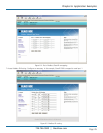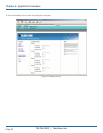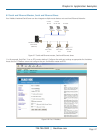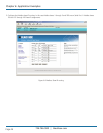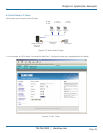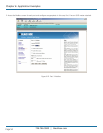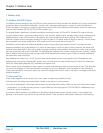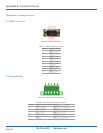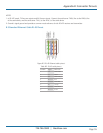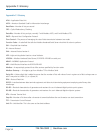
724-746-5500 | blackbox.com
Page 52
724-746-5500 | blackbox.com
Chapter 7: Modbus Help
7. Modbus Help
7.1 Modbus ASCII/RTU Basics
The Modbus protocol emerged in the mid-1970s as an early protocol for linking terminals with Modicon PLCs using a master/slave
(sometimes called a master/client) relationship. A simple, open, message-based protocol, it caught on quickly and became a
de facto standard in the industry. It supports asynchronous point-to-point and multidrop communications and can be used with a
variety of serial interfaces (RS-232, RS-422, RS-485, modems, etc.).
The original Modbus specification included two possible transmission modes: ASCII and RTU. Modbus RTU mode is the most
common implementation, using binary coding and CRC error-checking. Modbus ASCII messages mode, though somewhat more
readable because it uses ASCII characters, is less efficient and uses less effective LRC error checking. ASCII mode uses ASCII
characters to begin and end messages, whereas RTU uses time gaps (3.5 character times) of silence for framing. The two modes
are incompatible, so a device configured for ASCII mode cannot communicate with one using RTU.
All Modbus communications are initiated by Modbus masters using a polling query/response format. The master can send
broadcast messages (using a slave address of 0), which all slaves accept, but do not reply to. More commonly, the master polls
individual slaves sequentially. In each poll, it sends a message containing a device address, followed by a function code, any data
that may be required, and an error check field. The addressed slave responds with a similar message structure. Typically, it repeats
back its address and the function code, and then sends a field indicating the number of bytes of data it is sending, followed by
the data and the error check field.
Slave addresses can range from 1 to 247. Function codes include several common ones typically used in all applications and
additional ones that may be implemented in specific cases. Common function codes include: Read Coil Status (01), Read Input
Status (02), Read Holding Registers (03), and Read Input Registers (04).
When a master sends a message to a slave, it expects to receive a valid response within a certain length of time. If the slave does
not receive the message, or if the slave receives the message but an error is detected, it does not respond. If the slave cannot
respond appropriately for some other reason (e.g. it does not recognize the function code), it will return a message containing an
exception response.
7.2 Hints and Tips
A few simple suggestions that may assist you if your system is experiencing problems include:
• Slowing down the polling rate may be helpful if power cycling doesn’t cure the problem.
• A common misperception is that every serial network must terminate with a resistor. While this was true of early serial network
configurations, it’s typically the wrong answer—contact Black Box Technical Support at 724-746-5500 or info@blackbox.com
and verify if you’re an exception.
A sometimes difficult problem is the difference in grounding voltage between various network locations. Stray voltage from
lightning or other sources may also find its way onto the network. These conditions make isolation necessary in many settings.




